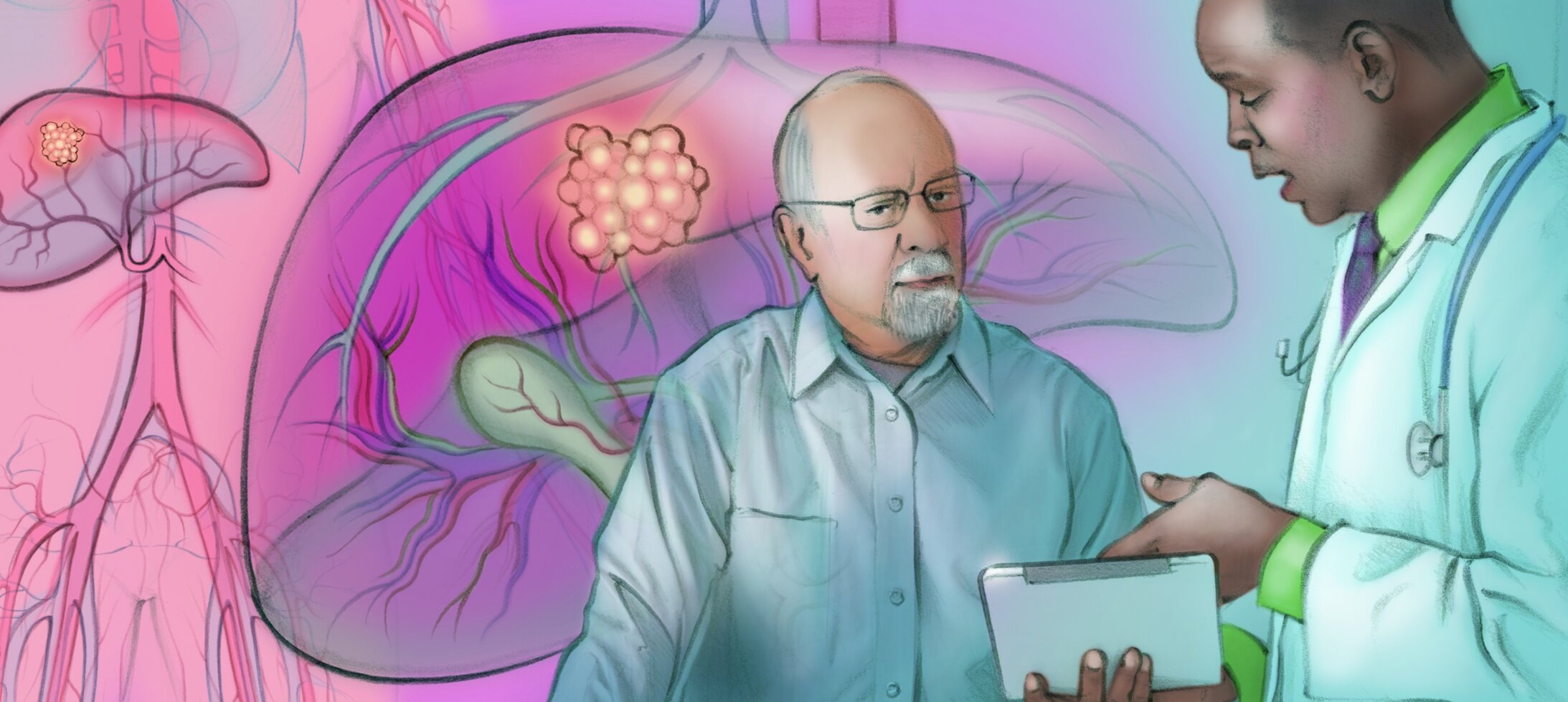What is the liver?
The liver is an organ in the right upper abdomen. It has many jobs. The liver makes juices that help digest food. It stores nutrients and energy from food. The liver also cleans toxins from the blood.
What is Liver Cancer?
Liver cancer is a type of cancer that starts in the liver. The most common type of liver cancer is called “hepatocellular carcinoma” or “HCC.” A less common form of liver cancer is called “cholangiocarcinoma”. Liver cancer is in the top 10 most common cancers in the world.
Cancer in the liver is not always liver cancer. Other types of cancer that start outside of the liver can spread to the liver.
What causes Liver Cancer?
HCC is caused by liver damage over time. Common causes of liver damage are hepatitis B virus, hepatitis C virus, heavy alcohol use, and obesity.
How is Liver Cancer treated?
Your liver cancer treatment options depend on your preferences and your unique conditions. These include your overall health as well as the size, location and number of tumors that you have. Sometimes you may benefit from a combination of these treatments.
No treatment. The disadvantage of this is that the cancer may continue to grow.
Surgery to cut the tumor out or to replace the liver with a transplant. Surgery can offer a cure. However, not everyone can have surgery.
Ablation is a minimally invasive, image-guided procedure to destroy the tumor with a wand placed through the skin. The wand kills the tumor with heat or by freezing it. Ablation works well for smaller tumors. It can be a cure.
Transarterial embolization (TACE or TARE) is another minimally invasive, image-guided procedure. It treats liver cancer by blocking the blood vessels that feed the tumor. This can be done with tiny beads soaked in cancer-killing medicine called chemotherapy. It can also be done with tiny radioactive beads. These options can be good for multiple tumors and larger tumors where surgery is not an option.
External radiation therapy is a series of treatments to destroy the tumor with radiation beams delivered from the outside.
Medicines can be used to treat liver cancer or help the immune system fight the cancer.
Watch our Without a Scalpel Episode on Liver Cancer
Frequently asked questions
How can tumors be destroyed without surgery?
A MIIP to destroy tumors inside the body without having to cut them out with surgery is called ablation. Ablation can cure a tumor.
A specialized doctor places a skinny wand through the skin and into the tumor then uses it to destroy the tumor in minutes using heat, freezing or alcohol. The dead tumor turns into a scar over time. Patients with just a few, small tumors in safe locations can be treated with ablation.
How are tumors treated through the blood vessels?
An artery is a blood vessel that carries blood from the heart to the rest of the body. Arteries form networks inside the body like highways. A specialized doctor can use a tiny tube to travel the body's arteries and reach the liver arteries directly feeding the tumor.
After numbing the skin, the doctor enters an artery in the groin or wrist through a pinhole. Using moving x- rays to see inside the body, the doctor then sends a tiny tube over soft wires to the liver arteries feeding the tumor. The doctor uses this tube to feed the tumor tiny beads soaked in chemotherapy. These beads kill the tumor over days to months by blocking the tumor’s blood supply and soaking it in poison.
This MIIP is called chemoembolization. It has advantages over giving the chemotherapy to the entire body through an IV. It allows the doctor to give 10 times higher doses directly to the tumor and avoid most side effects to the rest of the body.
A similar MIIP is called radioembolization. It kills liver tumors using radiation energy instead of poison. The specialized doctor sends very tiny radioactive beads directly into the liver arteries through a tiny tube. The radiation can only travel 1/4 inch away from the beads so it concentrates in the liver.
These beads are so small that they do not plug up the liver arteries very much. Radioembolization can be safer in patients where blocking the liver arteries could hurt their liver.
Radioembolization is different from giving radiation from the outside. Radioembolization treats the liver from the inside and limits damage to areas around the liver.
What are the risks and side effects of these MIIPs to treat liver cancer?
Because these MIIPs to treat liver cancer are performed through pinholes, there is a lower risk of side effects. All procedures carry a small risk of bleeding, infection and damage to other tissues. If the liver is very sick, there can be a risk of liver failure. Your doctor will discuss all the risks that are relevant to you so you can make an informed decision about your treatment.
Additional Resources:
About liver cancer:
About TACE and embolization:
About ablation:
About MIIPs for liver cancer:


